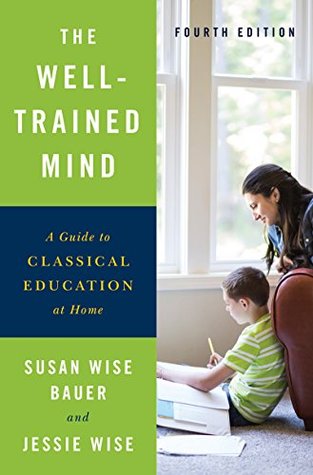More on this book
Community
Kindle Notes & Highlights
During the first four years of education, you have two purposes: not only to get the child to read quickly, well, and habitually, but to fill his mind with stories of every kind—myths, legends, classic tales, biographies, great stories from history.
First grade Ancients (5000 B.C.–A.D. 400)
Is 2016-2017 year is kinda Charlotte's third grade year, however she is only seven. She studied Old Testament and Ancient Egypt last year and this year is studying New Testament, Ancient Greece and Rome. Althea is starting Kindergarten at five this year. So maybe next year I can start to combine them in studies. I've been making things too difficult as "school at home" instead of "love of learning" and this needs to change.
Begin with twenty to thirty minutes of reading, three times per week, in first grade; you’ll want to work up to forty-five minutes by fourth grade.
Don’t overlook audiobooks as a supplement to (not a replacement for) reading.
Younger students will need you to ask them specific questions about the book:
For first grade and second grade, you should write the narration down, have the child read it back to you, and then place it under My Reading.
Narration removes the need for “comprehension exercises.”
Every three or four weeks, the child should also memorize a poem and recite it to you.
Aim for memorization of at least four to eight short poems during each school year.
When a poem has been memorized and recited to your satisfaction, write it out (or have the child write it out, if his skills are up to the job) and place it in the Memory Work section of the Literature notebook along with the date of recitation.
Continue making notebook pages once or twice a week and filing them under My Reading in the Literature notebook.
Continue to make notebook pages once or twice a week, summarizing the books the child is reading.
It is not necessary for your elementary student to be answering critical questions about the books he’s reading, either for literature or in his other studies.
The elementary years are a time to fill the student’s mind with as many different stories as possible.
There will be plenty of time to develop skills in literary analysis in the years to come.
Spelling, grammar, reading, and writing are related skills, but they ask for different kinds of mastery.
The goal of grammar study is to make those rules and conventions second nature to the student,
grammar exercises should be done orally—either
by fourth grade, grammar study can expand to thirty minutes per day.
By the end of fourth grade, the child should know the proper names and usages of all the parts of speech, the rules of punctuation and capitalization, dictionary use, and proper sentence structure.
fifteen minutes per day,
until the child is comfortable with all cursive letters, she can continue to print her spelling and writing assignments.
Continue penmanship through at least the end of fourth grade.
In grades 1–4, students should progress from copywork to dictation, and from oral narration (retelling passages from history, science, or literature) to written narrations.
during first grade, she’ll copy out sentences from good writers, practicing the look and feel of properly written language.
From second grade on, rather than putting the written model in front of the student, you will dictate sentences to her.
In third grade, students will begin to use part of their own narrations as dictation exercises. They will tell you the narration; you will write it down for them, and then dictate the first sentence back to them.
Encourage any creative impulses.
But don’t require the child to be creative during the grammar stage of education. She’s still absorbing and taking in. If she’s naturally creative, fine. If not, demanding creativity will only be counterproductive.
But you don’t necessarily need a “writing curriculum” to teach these skills. Copywork, dictation, and narration can be practiced as part of literature, history, and science.
Copywork and dictation can also be drawn from the student’s work across the curriculum.
Once your child is copying sentences easily, move on to dictation (usually around second grade).
By third grade, begin to encourage the child to do all formal work using cursive writing.
The New York Times Parent’s Guide to the Best Books for Children. 3rd ed. New York: Three Rivers Press, 2000.
The Frances series.
The Story of Ferdinand,
Make Way for Ducklings
Blueberries for Sal.
The Paper Bag Princess.
The Curious George series.
The True Story of the Three Little Pigs,
Sylvester and the Magic Pebble
Alexander and the Terrible, Horrible, No Good, Very Bad Day,
The Lyle the Crocodile
The Harry series,
The Bible
The Trojan Horse: How the Greeks Won the War.


